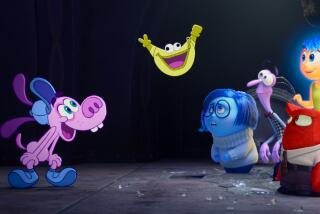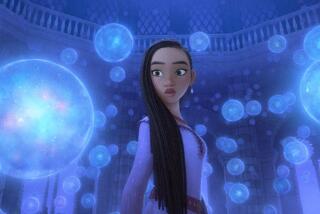Playing Hide-and-Seek With Conventional Wisdom
- Share via
At a time when most major Hollywood films seem to be formulaic additions to one franchise or other, Chris Sanders and Dean DeBlois, the directors of Walt Disney Studios’ “Lilo & Stitch,” have managed to make an animated feature that is unconventional, if not downright quirky.
The story of a destructive alien who crashes on Earth and is adopted by a lonely little Hawaiian girl, “Lilo” reflects the personal vision of Sanders and DeBlois. They not only directed the hand-drawn animated feature, they wrote the script, working from an idea of Sanders’, and storyboarded the entire film.
Ordinarily, those duties would be divided among a dozen or more artists. But in this time of Disney cutbacks in animation, that was a luxury the film couldn’t afford--and that may have worked to its benefit.
“We made a commitment to turn out a film that would be unusual, but that would be made very efficiently,” says Sanders. “We knew how much time and energy could be bled off if the director, writer, editorial crew and story crew weren’t working in perfect sync. We thought if we could close those gaps, we could make the leading end of the production much more efficient.”
DeBlois says that by sheltering their film from the “levels of reinterpretation that normally occur during the process,” they could give “Lilo” a consistent voice--for better or worse.
That original voice represents a gamble on Disney’s part, even though Walt Disney’s early animated features were considered boldly innovative when they were released. Conventional wisdom maintains that modern children have grown so accustomed to formula entertainment that they won’t accept anything that breaks the familiar patterns. Proponents of this view cite Warner Bros.’ “The Iron Giant,” which failed to connect with family audiences despite being one of the best-reviewed films of 1999.
“Lilo” is also bucking the trend toward computer-generated animation, which has produced most of the blockbuster hits over the last few years (“Shrek,” the “Toy Story” films). And the film faces stiff competition through the summer from DreamWorks’ animated “Spirit: Stallion of the Cimarron,” which continues to do solid business a month after its release.
DeBlois and Sanders say that from the outset, they had the support of Disney feature animation chief Thomas Schumacher for “Lilo,” which was produced in the studio’s Orlando, Fla., animation facility for far less than the cost of Disney’s recent animated features, and that he allowed them a great deal of freedom to follow their vision. Says DeBlois: “I think everyone’s aware that the decision-by-committee approach to filmmaking leads to recycled cliches.”
Recalls Sanders: “We took a risk by making this a real, believable family that had arguments and did strange things: A lot of things that Lilo does are completely illogical and yet very believable. The first thing Tom said was, ‘I love the damaged nature of this character,’ and from that point on, he was a champion of it and protected it and created an environment where we knew we were safe to experiment.”
The experiment seems to be working, at least critically; “Lilo” opened Friday to generally rave reviews.
Although Sanders had toyed with ideas for a children’s book about a Stitch-like monster since 1987, the film grew out of a studio retreat where executives and artists met to discuss animation and its future. Many artists expressed a desire to move away from the epic scale of recent features and make a smaller film that would be closer in tone to “Dumbo.” Sanders pitched his idea to Schumacher, who told him to start developing it.
The artists had worked together as co-heads of story on “Mulan,” but it wasn’t until “Lilo” was underway that they discovered that their work habits were distressingly similar. “When it comes time to storyboard, we both wait until the last second,” says Sanders.
“One night Andreas Deja, who animated Lilo, invited us over with some other people. Suddenly Dean looked at his watch and said, ‘Oh, it’s 9 o’clock. I really should get home and start storyboarding so I can be crying by 2.’ And I said, ‘What? I do that too!’ We start storyboarding the night before the assignment’s due, and by about 2 a.m. we each reach a point where we’re sobbing, ‘I can’t do this. It’s impossible.’ ”
Although they clearly enjoy each other’s company, the directors offer a study in contrasts. Blond, athletic-looking Sanders radiates a nervous energy that suggests a toy that’s been wound a few turns too tightly. DeBlois is taller, darker and huskier; he sits quietly with his hands folded while Sanders fidgets. Yet they worked comfortably together, with little friction.
“For the most part, we divided the film up sequence by sequence, and whoever felt passionately about a sequence took the lead on it,” explains Sanders.
Both artists wanted to push the boundaries and make a film that would be unlike other recent animated features: no spunky teenage heroines, no misunderstood heroes, no wisecracking sidekicks, no scheming villains.
“Neither of us likes slapstick humor very much, and we don’t like cheap sitcom one-liners,” says DeBlois. “In ‘Mulan,’ we felt we created a character who was very accessible because she wasn’t particularly good at anything. She wasn’t born into the aristocracy, she acted on instinct, she made stupid decisions, she was often impulsive, yet she had a nobility. We wanted all the characters in this film to exist in that kind of gray zone without archetypical heroes and villains.”
Sanders agrees: “The scale of a story has nothing to do with the feelings inside it. We felt a small story would be a better environment for big feelings and deep feelings. It’s harder to connect with a film where the villain is out to destroy the world than with a film where a bully tramples the school project some little kid spent all night working on. We wanted this film to draw on emotions that are more personal and believable and thus more powerful.”
In addition to his other duties, Sanders provided the grunting noises and guttural voice of the alien Stitch. “When I was a kid, I used to do this weird voice to entertain myself and to annoy others.”
DeBlois suggested that Sanders do that voice on the temporary soundtrack. When they had to record the final sounds, the directors felt it would be awkward to ask a “real” actor to squeak and grunt, so Sanders did. But when the story required Stitch to speak a few lines of understandable dialogue, he got nervous.
“I really relied on Dean to coach me through it. It’s the only time in my life I really had to act, so it was a very, very tense moment.”
Although DeBlois provided temporary voices for several characters, his only contribution to the final voice track is an indirect one.
“Dean has a little dog named Theodore that looks a lot like Stitch,” says Sanders. “We brought Theodore in, and he ate cookies and drank water and grunted and panted and made slobbery noises in front of a mike. We mixed a little of that in where Stitch is being horrid and licking stuff.”
Sanders and DeBlois would like to see “Lilo & Stitch” initiate a new era of animation production, in which major studios produce smaller, more personal works as well as musical adventure-romances. The watercolor artwork is dazzling, but the animation lacks the polish and depth of such recent Disney features as “Tarzan” and “Beauty and the Beast”--and also the price tag.
Although Disney never releases the budgets of its animated features, sources within the animation industry place the figure at less than half of the usual $100-million cost of a studio feature animation release.
DeBlois concludes, “We hope this film opens the door to less conventional story lines and gutsier storytelling with less financial risk, because we’ve proven it can be done.”
More to Read
Only good movies
Get the Indie Focus newsletter, Mark Olsen's weekly guide to the world of cinema.
You may occasionally receive promotional content from the Los Angeles Times.










